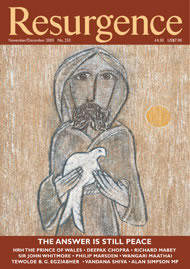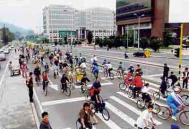ENRIQUE PEÑALOSA'S ideas stand as beacons of hope for cities of the non-industrialised world, which will absorb much of the planet's population growth over the next half-century. These are places with the usual complications of rapid urban expansion aggravated by deep poverty. Based on his experiences in Bogotá, however, Peñalosa believes it's a major mistake to give up on these places, no matter how out of control their problems appear.
"If we in the Third of the World measure our success or failure as a society in terms of income, we would have to classify ourselves as losers until the end of time," declares Peñalosa, a tall man with salt-and-pepper hair and trim beard. "With our limited resources, we have to invent other ways to measure success. This might mean that all kids have access to sports facilities, libraries, parks, schools or nurseries."
This is exactly what Peñalosa set out to do as mayor of Colombia's capital city. And the results were impressive enough that Colombia finally got international press about something other than drug trafficking, guerrilla kidnappings and civil war. Indeed, some observers claim that this city of 6.6 million offers practical lessons, not just for helping poor cities, but for upgrading the quality of life in cities of the industrialised world.
In just three years 1998-2001 (term limits prevented him from seeking a second term) Peñalosa's Administration:
- created the Trans-Milenio, a bus rapid transit system (BRT), which now carries half a million passengers daily on special bus lanes that offer most of the advantages of a metro at a fraction of the cost;
- built fifty-two new schools, refurbished 150 others and increased student enrolment by 34%;
- established or refurbished 1,200 parks and playgrounds;
- built thirteen libraries;
- built 100 nurseries for children under five, and found permanent sources of funding;
- improved life in the slums by bringing water to all households and buying land on the outskirts of the city to prevent real-estate speculation and ensure that affordable housing will be built;
- saw the murder rate fall by two-thirds;
- reclaimed the sidewalks from motorists, who traditionally saw them as either a passing lane or a parking lot;
- established 300 kilometres of cycleways;
- created the world's longest pedestrian street (17 kilometres);
- reduced traffic by 40% with a system where motorists must leave cars at home during rush hour two days a week;
- inaugurated an annual car-free day; and
- planted 100,000 trees.
NO-ONE CAN accuse Peñalosa of thinking small. As we sit in a room at New York University's Center for Latin American and Caribbean Studies, looking out on the bustle of Greenwich Village below, he muses about the day when cities of the Third of the World might surpass New York or Paris in terms of sheer joyfulness in urban living. As he confides this, his reserved manner gives way to a broad and infectious grin, which I assume has proved very useful through the years in helping him get things done.
"You must remember that Third of the World cities are still two-thirds unbuilt," he tells me, explaining that by 2050 most of these cities will be three times larger than today, which means there is still a lot of city planning to do. "We can take advantage of the mistakes and successes of other cities."
Opening the window and gazing down at sidewalks filled with people, he says, "I love New York. I feel so much energy here. But there is so much more that you could do: pedestrian streets, more parks, bikeways, open up the waterfronts. The old sections of European cities are very beautiful, but even they could be improved. They need a network of pedestrian streets through the whole city, not just the centre, and they need more sports facilities and parks and green space.
"In Spanish we have this saying that it doesn't cost anything to dream," he notes. "So I say, let's dream! Let's just imagine how you want your home to be. How you want your kids to live. Do you want to walk or drive to get bread? That's the basis of thinking about cities."
A more serious look now crosses his face. "Ninety-nine per cent of Third of the World people have never seen a Dutch or Danish city, where you see people on bikes everywhere. A city full of cars is not a good model for us. The images we get from the US are a very damaging model," he continues. "We need to avoid undesirable developments such as urban sprawl. People in the US now recognise there are problems with building cities for cars and not for people. Pedestrians and bicyclists should be given as much importance as motor vehicles; even more so in Third of the World cities, where most households don't own cars."
It's not that Peñalosa hates cars. It's that he loves lively public places where people of all backgrounds gather to enjoy themselves and each other - places that barely exist in cities where the car is king. These places are even more important in poor cities than in wealthy ones, he says, because poor people have nowhere else to go.
"We all need to see other people. We need to see green. Wealthy people can do that at clubs and private facilities. But most people can only do it in public squares, parks, libraries, sidewalks, greenways, public transit," he declares, turning back for another look out of the window.
GROWING UP IN the 1960s, when revolutionary fervour in South America was strong, Peñalosa became an ardent advocate of social justice and income redistribution at an early age. He studied economics and history and later moved to Paris to earn a doctoral degree in management and public administration. He returned home with aspirations of bringing European-style city comforts to the working-class people of Bogotá. The experience of his early years out of school working in an investment banking firm and dabbling in politics redefined his political views, as seen by the title of his first book, Capitalism: The Best Option. But this does not mean, he hastens to tell me, that he abandoned the quest for social justice.
"We live in the post-Communism period, in which many have assumed equality as a social goal is obsolete," he explains. "Although income equality as a concept does not jibe with market economy, we can seek to achieve quality-of-life equality. Urban policy can be a powerful means to achieve equality in quality of life."
So over the last twenty years Peñalosa has been looking for new ways to level the playing field between poor citizens and wealthier ones. "The least a democratic society should do", he says, "is to offer people wonderful public spaces. Public spaces are not a frivolity. They are just as important as hospitals and schools. They create a sense of belonging. This creates a different type of society - a society where people of all income levels meet in public space is a more integrated, socially healthier one."
"In Bogotá, our goal was to make a city for all the children. The measure of a good city is one where a child on a tricycle or bicycle can safely go anywhere. If a city is good for children, it will be good for everybody else."
Peñalosa has been taking this message throughout the world in lecture tours sponsored by the World Bank, the Institute for Transportation and Development Policy (ITDP - a New York-based group promoting sustainable transportation in the Third of the World), and Interface for Cycling Expertise (I-CE), a group based in Utrecht, the Netherlands promoting bike transportation.
"You cannot overestimate the impact Peñalosa has had, on a personal level, in ten or twelve countries," notes Walter Hook, director of ITDP. "He takes these ideas, which can be rather dry, and speaks emotionally about the ways they affect people's lives. He has the ability to change how people think about cities."
Bogotá's BRT system is of particular interest to public officials in the Third of the World, who want to defuse traffic jams but don't have funds to build a metro or tram system. Hook gives Peñalosa major credit for the decision to build a new busway in Jakarta, Indonesia. He also played a role in getting things rolling for busways in Beijing, Delhi, Cape Town, Lima and Dar es Salaam, as well as ambitious cycleway projects in Mexico City, Cape Town and Dakar.
AFTER SEVERAL HOURS of conversation, interrupted once by university maintenance men coming in to fix the loose window that Peñalosa favours for surveying the city below - a moment in which I saw the mayor's charm and persuasiveness in full blossom as he enquired whether they were going to seal it permanently shut - it is now time for lunch. Peñalosa tentatively suggests we could go to the faculty club, a presumably swank spot. I counter-offer that Washington Square Park is only two blocks away, and see a smile light up his face. We swing by a local deli, where Peñalosa holds his own in simultaneous Spanish conversations with two employees from the Dominican Republic while continuing to answer my questions in English, and then stroll over to Washington Square to enjoy a lovely summer afternoon.
The park, the hub of Greenwich Village, was saved from plans to run a highway right through it by protests from the neighbourhood. As Peñalosa and I sit down on a bench with our sandwiches, we stop talking for the first time all day and just watch the show. Children play. Mothers chat. Students read. Construction workers sip coffee. Business executives nap. Street people sing. When a young woman glides by on her bike, Peñalosa nods his head and laughs. "Bikes are a wonderful thing in cities. You can watch all the other people on their bikes, meet your friends, stop to talk."
"All these issues we're talking about are from the soul," he adds. "Economics, urban planning, ecology are only the means. Happiness is the goal. Places like this make people happy. We have a word in Spanish, ganas, which means 'a burning desire'. I have ganas about public life…"
Just then a young couple walk by pushing their bikes.
He looks over at me, his brown eyes shining. "Have you seen all the bikes in Copenhagen?"
In preparing this article, our editorial team discussed the use of the term
'Third World', which in some cases can seem derogatory. From research we were interested to find that the term is actually a translation error: "The term was coined in French as Tiers Monde ('Third of the World'), but it has since been mistranslated to mean 'third in order'. No order is implied by Tiers Monde (if so, it would have been Troisième Monde). The term was used during the Cold War and the originator of the term noted simply that about a third of the countries of the world were neither capitalist nor communist in their political commitment. They were mostly the poorer countries of Africa, Asia and Latin America." As a mark of respect for the Third of the World countries who are still able to choose a more sustainable political future, from now on we will use the term as it was originally envisaged.







